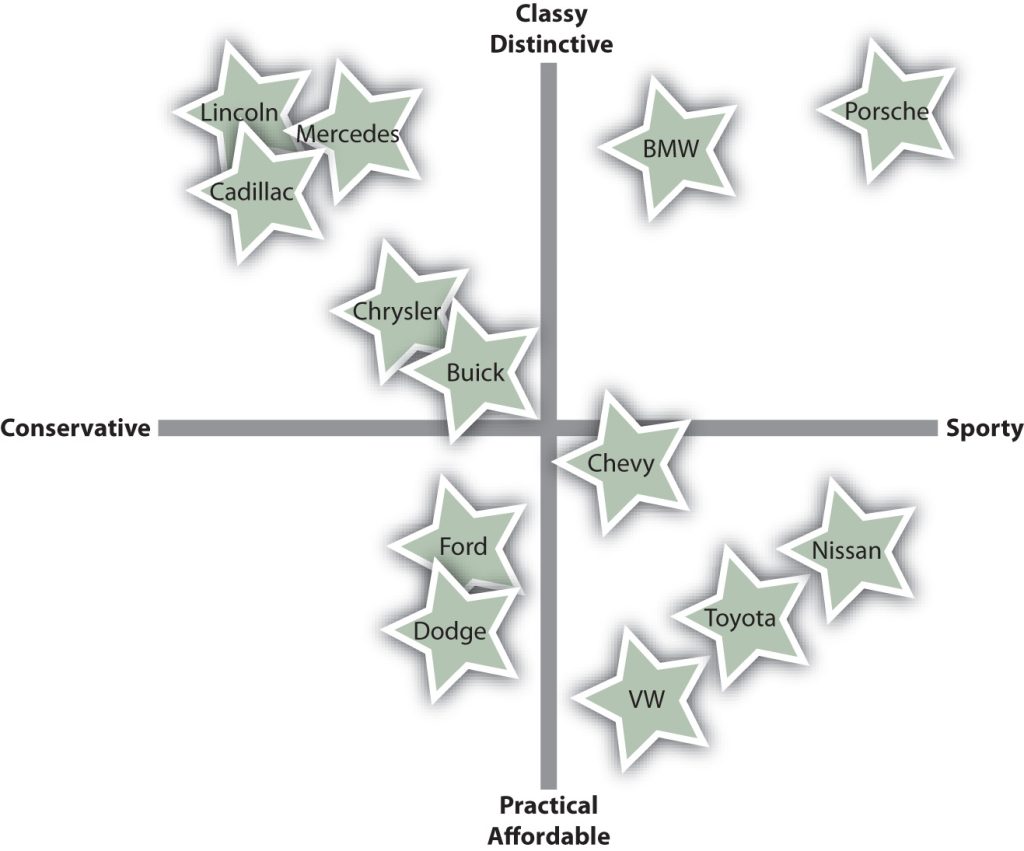5.4 The STP Process – Step 5
Step 5: Positioning and Repositioning Offerings
Why should buyers purchase your offering versus another? If your product faces competition, you will need to think about how to “position” it in the marketplace relative to competing products. After all you don’t want the product to be just another “face in the crowd” in the minds of consumers. Positioning is how consumers perceive a product relative to the competition. Companies want to have a distinctive image and offering that stands out from the competition in the minds of consumers. Determining a positioning strategy is determining how an organization chooses to compete.
One way to position your product is to plot customer survey data on a perceptual map. A perceptual map is a two-dimensional graph that visually shows where your product stands, or should stand, relative to your competitors, based on criteria important to buyers, according to the target market’s perceptions. The criteria can involve any number of characteristics—price, quality, level of customer service associated with the product, and so on. An example of a perceptual map is shown in Figure 5.10 “An Example of a Perceptual Map” demonstrating the two attributes of classy/distinctive or practical/affordable and conservative or sporty. The various car brands are placed on the map according to consumers’ perceptions of each brand. To avoid head-to-head competition with your competitors, you want to position your product somewhere on the map where your competitors aren’t clustered. Note that these perceptions may or may not be factual. Research must be done to verify the accuracy as well as the strength of the perceptions.
Figure 5.4.1: An Example of a Perceptual Map

Source: Adapted from http://en.wikipedia.org/wiki/Perceptual_mapping.
Many companies use taglines in their advertising to try to position their products in the minds of the buyer—where they want them, of course. A tagline is a catchphrase designed to sum up the essence of a product. You perhaps have heard Wendy’s tagline “It’s better than fast food.” The tagline is designed to set Wendy’s apart from restaurants like McDonald’s and Burger King—to plant the idea in consumers’ heads that Wendy’s offerings are less “fast foodish,” given the bad rap fast food gets these days.
Sometimes firms find it advantageous to reposition their products—especially if they want the product to begin appealing to different market segments. Repositioning is an effort to “move” a product to a different place in the minds of consumers. The i-house, a prefab house built by Clayton Homes, a mobile home manufacturer, is an example. According to the magazine Popular Mechanics, the i-house “looks like a house you’d order from IKEA, sounds like something designed by Apple, and consists of amenities—solar panels, tankless water heaters and rainwater collectors—that one would expect to come from an offbeat green company out of California selling to a high-end market” (Schwartz, 2009). A Clayton Homes spokesperson says, “Are we repositioning to go after a new market? I would think we are maintaining our value to our existing market and expanding the market to include other buyers that previously wouldn’t have considered our housing product1.”
Figure 5.4.2: The Clayton i-house: “A Giant Leap from the Trailer Park”

Source: http://www.claytonihouse.com. 1“Clayton ‘i-house’ Is Giant Leap from Trailer Park,” Knoxvillebiz.com, May 6, 2009, http://www.knoxnews.com/news/2009/may/06/clayton-i-house-giant-leap-trailer-park/ (accessed April 13, 2012).
However, as time passes, the need to change the competition strategy may occur. This results in repositioning. Repositioning means that activities are undertaken to change how a brand / product / company is perceived relative to the competition.
Conclusion
STP is a process that allows organizations to understand potential buyers better while addressing the marketing mix to meet the needs and desires of their target market. The process starts with segmentation which divides the market into groups based on attributes pertaining to the offering. Targeting is the analysis behind choosing the segment(s) that the organization can satisfy, compete, and still be profitable. Positioning is determining the attributes most important to the target market and how we desire to be perceived compared to the competition.
References
3“Bluetooth Proximity Marketing,” April 24, 2007, http://bluetomorrow.com/bluetooth-articles/marketing-technologies/bluetooth-proximity-marketing.html (accessed December 2, 2009).
4“U.S. Framework and VALS™ Type,” Strategic Business Insights, http://www.strategicbusinessinsights.com/vals/ustypes.shtml (accessed December 2, 2009).
Birchall, J., “Out to Launch in a Downturn,” Financial Times, June 4, 2009, 10.
Birchall, J., “Value Trend Tests Brand Loyalty,” Financial Times, March 31, 2009, 12.
Ford, H., My Life and Work (Garden City, NY: Garden City Publishing Co., 1922), 72.
Graham, J., “Cade Decoratero Finds Twitter a Sweet Recipe for Success,” USA Today, April 1, 2009, 5B.
Harler, C., “Reaching the Unreachable,” Smart Business Cleveland, December 2008, 92.
Manzanedo, J. M., “Market Segmentation Strategies. How to Maximize Opportunities on the Potential Market,” February 20, 2005, http://www.daemonquest.com/en/research_and_insight/2006/10/11/market_segmentation_strategies_how_to_maximize_opportunities_on_the_potential_market (accessed December 1, 2009).
Marco, M., “LEAKS: Best Buy’s Internal Customer Profiling Document,” The Consumerist, March 18, 2008, http://consumerist.com/368894/leaks-best-buys-internal-customer-profiling-document (accessed December 2, 2009).
Peppers D. and Martha Rogers, “The Short Way to Long-Term Relationships,” Sales and Marketing Management, May 1, 1999, 24.
Peppers, D., Martha Rogers, and Bob Dorf, “Is Your Company Ready for One-to-One Marketing?” Harvard Business Review, January–February 1999, 151–60.
Spellings, R. Jr., “Mass Marketing Is Dead. Make Way for Personal Marketing,” The Direct Marketing Voice, March 20, 2009, http://thedirectmarketingvoice.com/2009/03/20/mass-marketing-is-dead-make-way-for-personal-marketing (accessed December 2, 2009).
Barry, T., Mary Gilly, and Lindley Doran, “Advertising to Women with Different Career Orientations,” Journal of Advertising Research 25 (April–May 1985): 26–35.
Berkowitz, E. N., The Essentials of Health Care Marketing, 2nd ed. (Sudbury, MA: Jones & Bartlett Publishers, 2006), 13.
Cox, B., “GM Hopes Its New Managers Will Energize It,” Fort Worth Star-Telegram, August 29, 2009, 1C–4C.
Donnelly, J. H., preface to Marketing Management, 9th ed., by J. Paul Peter (New York: McGraw-Hill Professional, 2002), 79.
Harrison, M., Paul Hague, and Nick Hague, “Why Is Business-to-Business Marketing Special?”(whitepaper), B2B International, http://www.b2binternational.com/library/whitepapers/whitepapers04.php (accessed January 27, 2010).
Hill, B. J., Carey McDonald, and Muzzafer Uysal, “Resort Motivations for Different Family Life Cycle Stages,” Visions in Leisure and Business Number 8, no. 4 (1990): 18–27.
Miller R. K. and Kelli Washington, The 2009 Entertainment, Media & Advertising Market Research Handbook, 10th ed. (Loganville, GA: Richard K. Miller & Associates, 2009), 157–66.
Nee, E., “Due Diligence: The Customer Is Always Right,” CIO Insight, May 23, 2003.
Reisenwitz, T., Rajesh Iyer, David B. Kuhlmeier, and Jacqueline K. Eastman, “The Elderly’s Internet Usage: An Updated Look,” Journal of Consumer Marketing, 24, no. 7 (2007): 406–18.
Schlacter, B., “Sugar-Sweetened Soda Is Back in the Mainstream,” Fort Worth Star-Telegram, April 22, 2009, 1C, 5C.
Tornoe, J. G., “Hispanic Marketing Basics: Segmentation of the Hispanic Market,” January 18, 2008, http://learn.latpro.com/segmentation-of-the-hispanic-market/ (accessed December 2, 2009).
von Hoffman, C., “For Some Marketers, Low Income Is Hot,” Brandweek, September 11, 2006, http://cfsinnovation.com/content/some-marketers-low-income-hot (accessed December 2, 2009).
Corbett, S., “Can the Cellphone Help End Global Poverty?” New York Times Magazine, April 13, 2008, http://www.nytimes.com/2008/04/13/magazine/13anthropology-t.html?pagewanted=all (accessed December 2, 2009).
Daniel, McGinn, “Cheap, Cheap, Cheap,” Newsweek, February 2010, 10.
de la Merced M. J. and Chris V. Nicholson, “Heineken in Deal to Buy Big Mexican Brewer,” New York Times, January 11, 2010, http://www.nytimes.com/2010/01/12/business/global/12beer.html (accessed January 26, 2010).
Schiffman L. and Leslie Kanuk, Consumer Behavior, 10th ed. (Upper Saddle River, NJ: Prentice Hall, 2010), 80.
Sewell, D., “P&G May Make Changes as it Faces Challenges,” The Associated Press, June 9, 2009.
Simon, B., “Alternative Routes For Survival,” Financial Times, April 23, 2009, 8.
Wheatley, J., “Business of Beauty Is Turning Heads in Brazil,” Financial Times, January 20, 2010, 5.
Gapper, J., “Why Brands Now Rise in the East,” Financial Times, April 23, 2009, 9.
Schwartz, A., “Clayton Homes’ i-house Combines Energy Efficiency and Modular Affordability,” Fast Company, May 4, 2009, http://www.fastcompany.com/blog/ariel-schwartz/sustainability/clayton-homes-75k-energy-efficient-i-house (accessed December 9, 2009).

